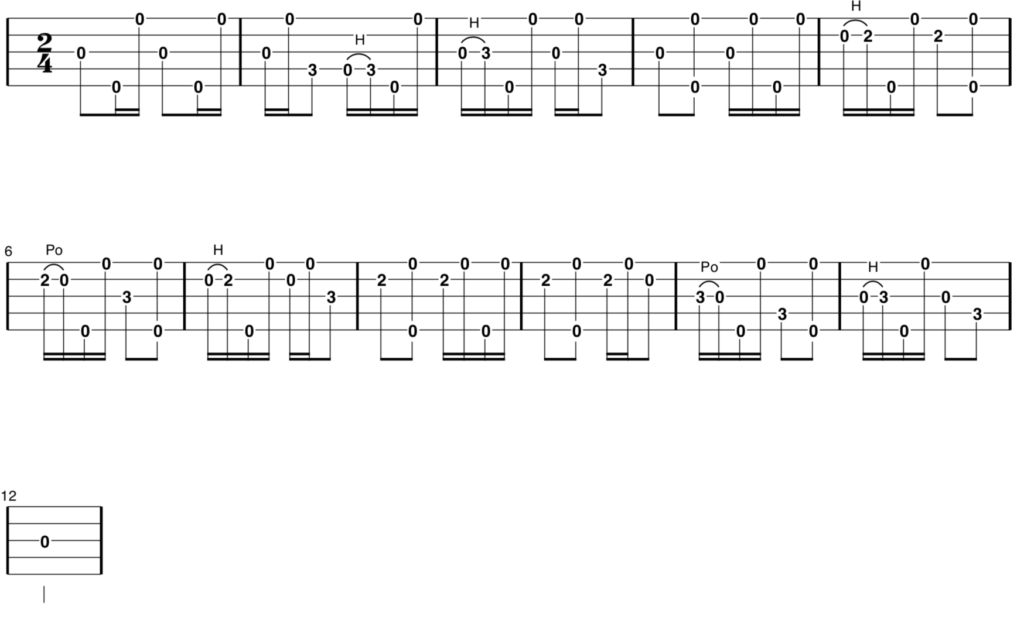Welcome to Step 6! The finish line is near!
In this video, you’ll learn your second technique for sounding notes on the off beat with your fretting hand.
Your Mission: Watch the video, and then practice the assigned exercise along with the “Beats for Banjo” practice tracks.
When To Move On: Move on to the next lesson when you can play the assigned exercise cleanly and with good timing along with the backing track (any tempo is fine).
THE LESSON (STEP 6)
YOUR PRACTICE EXERCISE

LINKS MENTIONED
1) Click here to subscribe to the Fingerstyle Banjo Channel
2) The Laws of Brainjo: The Art & Science of Molding a Musical Mind – the book outlines the theoretical principles of the Brainjo Method of instruction.
3) The Course Book (when ready):
BEATS FOR BANJO TRACKS
FULL TRANSCRIPT
Okay. It is time for step six. Only two steps left in the seven essential steps to two fingers only banjo crash course for the total beginner. All right, so in this episode we will be learning our final foundational technique for 2 finger thumb lead banjo and as usual we will be inserting this technique into our arrangement for Pretty Polly.
Once again, if you haven’t watched the prior steps I would highly encourage you to do so, and remember that central headquarters for the course is fingerstylebanjo.com/twofinger. Two finger spelled out.
Okay, so in the last episode, we covered our first fretting hand technique, which is the hammer on and remember that fretting hand techniques are where we’re playing a note with our fretting finger, not with our picking finger and they allow us to play melody notes, in this case melody notes on the off beats, which is a really handy thing because it allows us to steal back some melody notes that we may have sacrificed, and it also allows us to naturally syncopate things.
Now let me demonstrate the technique for the pull off. Some people refer to this as a pluck off to emphasize the idea that really all we’re doing here is plucking a string with our fretting finger.
Most of the time we’re doing that from a fretted stream. So for example, if I’m fretting the third fret of the fourth string here and I play it and then pull off, it sounds like this. But here what I’m doing is I’m not just lifting my finger off, but I’m actually plucking it as I’m doing so. So if I just pulled it off, it’s got a soft sound. If I pluck off, I get a nice clear sound and in fact we talked last time about the hammer on. When you hammer onto a note, the second sound is generally a little bit softer. With a pull-off or a pluck off, since you’re plucking the string just like you’re doing when you’re plucking it with your picking fingers, you’re going to generate a note of equal volume or you can be.
And just like the hammer on, we can pull off from a string where you just played that we’re fretting, or we can actually play one string and pluck or pull off another one. So there I’m playing the open second and then I’m plucking off the open first. Again, as I mentioned before, these alternate string hammer ons and pull offs are commonly used in claw hammer banjo, but they come in really handy in two finger thumb lead style.
So I would encourage you just to practice first just to get the idea of this motion. Just practice plucking the string. Try this on the open first string, plucking it with your index finger and note, no matter where you pluck, you’re going to get the same note, right? First try it with your index, then your middle, then ring. You can try that on the other strings. Get the idea of the motion that you need to make with your finger in order to generate a note.
So again, you’re just plucking it with your finger, no different than what you, when you’re plucking down here with your right hand, only you’re just coming at it from the other direction. And then try doing that same thing after plucking a note.
Again, if I try third fret of the fourth string and then pull off, sounds like that. I can try second fret of the third string, pull off, second fret of the second string. Again, I’m using my index there. Third fret of the first string. And again, just practice doing that. See if you can get a nice clean sound on that second note.
This is probably technique-wise, maybe the most challenging one to get to where you’re comfortable with it and you can execute it in time. So don’t feel bad if it feels awkward at first. I really want you to first, make sure you have the idea that you’re just plucking a string with your fretting hand. If you get that and you get that basic motion, you should be good to go.
Okay, so let’s add in some pull-offs to practice in our song Pretty Polly. So there are only two spots in this arrangement where we are going to be playing a pull off. The first one I heard in section two, so section one is the same as we’ve played it before. Section two, the first measure sounds the same. Our first pull off comes at the beginning of the second measure here. We’ve had our finger RA on the second fret of the second string and we’re going to pull off to the open string. So again. So the whole measure sounds like this. Again. Okay?
And now we close out, the last two measures sound like this. And then in our third section we have one pull off in the second measure. So the first measure sounds the same, and our pull off occurs in the second measure, pulling off from the third fret of the third string to the open third with our index. That’s the pull off. The whole measure sounds like this. Again. And then we finish it out with.
Okay, so now here’s what our entire arrangement sounds like with our pull-offs added.
All right, when you are ready, then try practicing that along with the beats for banjo backup track and I will demonstrate here how that should sound. We’ll pull up the 70 beats per minute back up.
Okay, so practice that exercise to get ready for the next step. And again, the objective is to play that exercise with good timing and clean notes. The speed is not that important. What’s important is that you were able to keep time at whatever tempo you choose. And again, if you want to, if you need to slow it down even further by using the gear icon and adjusting the speed of the video, that is fine as well.
All right, that does it for this installment. If you have any comments or questions, feel free to leave them in the comment section below the video and I will see you in the next one.
 Subscribe to the Fingerstyle Banjo Channel
Subscribe to the Fingerstyle Banjo Channel